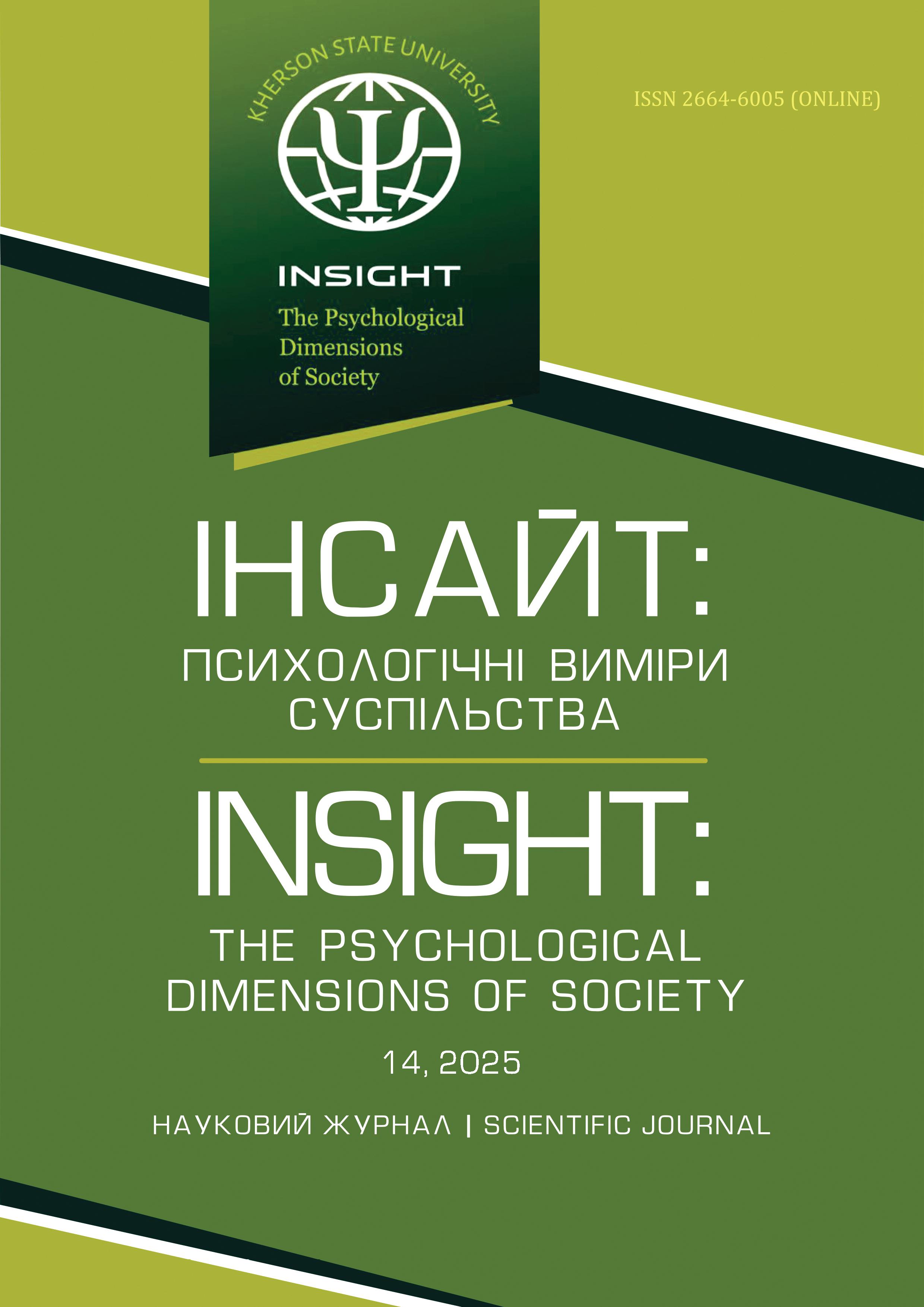Sex differentiation in the organization of emergency sensorimotor action
Abstract
The purpose of the study is to determine characteristics of the gender factor’s influence on the structure and speed of implementation of emergency sensorimotor action. The empirical research method is a computer-assisted laboratory experiment with an intrasubject implementation plan. The participants were students divided into two groups: 78 men and 74 women. In the series of attempts, the participants completed tasks of simple sensorimotor response, sensorimotor response, and two-choice response. In the two-choice response task, the subject is first given a reference point for the option of future stimulation, to which one should adjust urgently. After, the subject should act when the stimulus appears. The U Mann-Whitney test and Spearman’s Rank correlation coefficient were applied to process experimental data. Results. It is established that men surpassed women in the speed of simple sensorimotor response (U= 2147.00; p=.006) and sensorimotor choice response (U=1733.00; p<.001), and the reaction speed in a twochoice task with one possible stimulus (U=2078.00; p=.003) and three possible stimuli (U=2006.00; p=.001). Сompared to women, men spend less time on organizing emergency sensorimotor action under a rapid change in the current situation (U=2090.00; p=.003). It is found that in the male group, in contrast to the female one, the orientation time in a twochoice task correlates with the time of motor response in the variant with one possible stimulus (r=-.257; p=.023) and anticipation probability (r=.365; p=.001). Conclusions. The general structure of the organization of emergency sensorimotor action does not differ significantly in men and women. The time of simple sensorimotor response and choice reaction in individual tasks and, if required, their emergency selective implementation in a two-choice task is less in the male group than in the female one. Men have a faster organization of emergency sensorimotor action in response to rapid changes in the current situation than women. Compared to men, relative operational complexity for women regarding the differentiation of time references in the anticipation process since stimulus appearance is associated with a destabilization of the speed of sensorimotor action.
Downloads
References
Boyko, E. I. (2002). Mekhanizmy umstvennoy deyatel’nosti [Mechanisms of mental activity]. Voronezh: NPO “MODEK”. [in Russian].
Česonis, J. and Franklin, D. W. (2020). Time-to-Target Simplifies Optimal Control of Visuomotor Feedback Responses. Journal of Neuroscience, 7(2), 1–17. https://doi.org/10.1523/ENEURO.0514-19.2020
Cheban, Yu., Chebykin, O., Plokhikh, V., & Massanov, A. (2020a). Mental resources for the self-mobilization of rowing athletes. Journal of Physical Edu-cation and Sport, 20(3), 1580-1589 [in English]. https:// doi.org/10.7752/jpes.2020.03216
Cheban, Yu. V., Chebykin O. Ya., Plokhikh V. V., & Massanov A. V. (2020b). Emotional factor of competitive self-mobilization of professional rowers. Insight: the psychological dimensions of society, 3, 28-43. http://doi.org/10.32999/2663-970X/2020-3-2
Coe, J. L., Micalizzi, L., Josefson, S. (2020). Sex differences in associations between early adversity, child temperament, and behavior problems. International Journal of Behavioral Development, 44(6), P. 490-504. https://doi. org/10.1177/0165025420912012
Cravo, A. M., Rohenkohl, G., Santos, K.M., Nobre, A. C. (2017). Temporal Anticipation Based on Memory. Journal of Neuroscience, 7(2), 1-17. https://doi. org/10.1162/jocn_a_01172
Eaton, W. O., & Enns, L. R. (1986). Sex differences in human motor activity level. Psychological Bulletin, 100(1), 19–28. https://doi.org/10.1037/0033-2909.100.1.19 Gartstein, M. A., Hancock, G. R., Potapova, N. V., Calkins, S. D., & Bell, M. A. (2020). Modeling development of frontal electroencephalogram (EEG) asymmetry: Sex differences and links with temperament. Developmental science, 23(1). https://doi.org/10.1111/desc.12891
Jain, A., Bansal, R., Kumar, A., & Singh, K. D. (2015). A comparative study of visual and auditory reaction times on the basis of gender and physical activity levels of medical first year students. International Journal of Applied and Basic Medical Research, 5(2), 124– 127. https://doi.org/10.4103/2229-516X.157168
Merlin, V. S. (2005). Psikhologiya individual’nosti [Psychology of individuality]. M.: MPSI; Voronezh: NPO “MODEK”. [in Russian].
Plokhikh, V. (2021). Assessment of subject’s readiness for urgent actions using the variations of sensorimotor response tasks. Insight: the psychological dimensions of society: scientific journal, 5, 46-65. https://doi.org/10.32999/2663-970X/2021-5-4
Plokhikh, V., Popovych, I., Zavatska, N., Losiyevska, O., Zinchenko, S., Nosov, P., Aleksieieva, M. (2021). Time Synthesis in Organization of Sensorimotor Action. BRAIN. Broad Research in Artificial Intelligence and Neuroscience, 12(4), 164-188. https://doi.org/ 10.18662/brain/12.4/243
Plokhikh, V.V. (2011). Psikhologiya vremennoy regulyatsii deyatel’nosti cheloveka. [Psychology of temporary regulation of human activity]. Donetsk: Landon XXI. [in Russian].
Sadaphal, D. P., Kumar, A., & Mutha, P. K. (2022). Sensorimotor learning in response to errors in task performance. Journal of Neuroscience, 9(2), 1-14. https:// doi.org/10.1523/ENEURO.0371-21.2022
Shoshol, R. (1978). Vremya reaktsii. Eksperimental’naya psikhologiya [Reaction time. Experimental psychology]. M: Nauka. [in Russian].
Silverman, I. W. (2010). Simple reaction time: It is not what it used to be. The American Journal of Psychology, 123(1), 39-50. https://psycnet.apa.org/ doi/10.5406/amerjpsyc.123.1.0039
Usher, M., Olami, Z., McClelland, J.L. (2002). Hick’s Law in a Stochastic Race Model with Speed–Accuracy Tradeoff. Journal of Mathematical Psychology, 46(6), 704-715. https://doi.org/10.1006/jmps.2002.1420
Uznadze, D.N. (2001). Psikhologiya ustanovki. [Psychology of installation]. SPb.: Piter. [in Russian].
van Uffelen, J. G. Z., Khan, A. & Burton, N. W. (2017). Gender differences in physical activity motivators and context preferences: a population-based study in people in their sixties. BMC Public Health, 17, 624. https://doi.org/10.1186/s12889-017-4540-0
Vidal, F., Meckler, C., & Hasbroucq, T. (2015). Basics for sensorimotor information processing: some implications for learning. Front. Psychol., 6(33). https:// doi.org/10.3389/fpsyg.2015.00033
Wu, W. C., Chang, L.Y., Luh, D. L., Wu, С. C., Stanaway, F., Yen, L. L., Chang, H. Yi. (2020). Sex differences in the trajectories of and factors related to extracurricular sport participation and exercise: a cohort study spanning 13 years. BMC Public Health, 20, 1639. https://doi.org/10.1186/s12889-020-09745-8
Zinchenko, S., Tovstokoryi, O., Nosov, P., Popovych, I., & Kyrychenko, K. (2022). Pivot Point position determination and its use for manoeuvring a vessel. Ships and Offshore Structures, https://doi.org/10.1 080/17445302.2022.2052480
Authors who publish with scientific journal agree to the following terms:
• All scientific papers may be freely copied and distributed on any medium and in any format, provided that the references to the initial data of the scientific work are indicated.
• Authors retain copyright and grant the journal right of first publication with the work simultaneously licensed Creative Commons Attribution License .
• Authors are able to enter into separate, additional contractual arrangements for the non- exclusive distribution of the journal’s published version of the work (institutional repository, your website, monograph), with an acknowledgement of its initial publication in this journal.





































